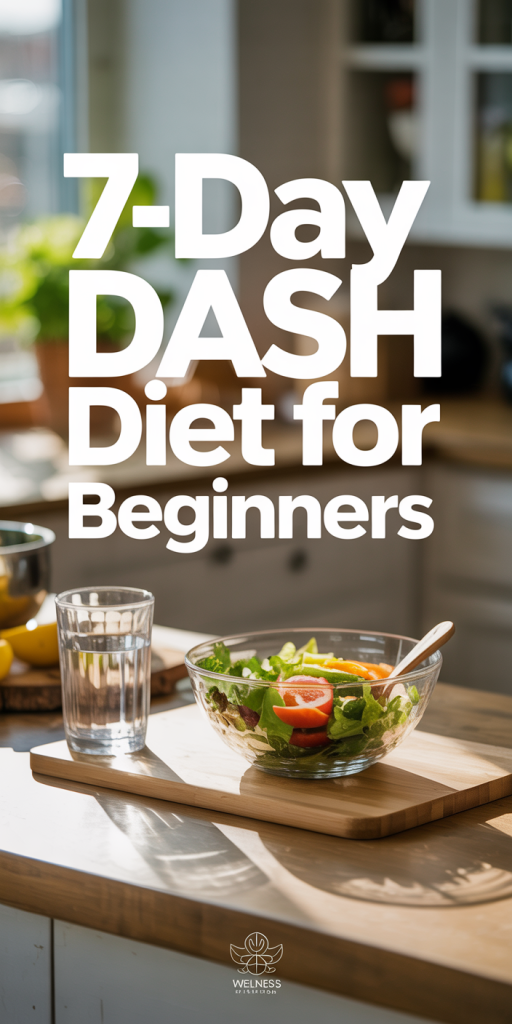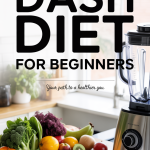7-Day DASH Diet for Beginners
Want a simple, practical way to eat healthier this week without feeling deprived? The DASH diet (Dietary Approaches to Stop Hypertension) is a sensible, real-world plan focused on vegetables, fruit, whole grains, lean protein, and less sodium. It’s not a fad — it’s designed to be flexible, family-friendly, and easy to stick with.
Below you’ll find a full 7-day beginner plan, easy recipes, a grocery list, portion notes, and simple tips to make it work for your life.
Quick primer: What the DASH diet emphasizes
- Lots of vegetables and fruit (aim for 4–5 servings of each per day).
- Whole grains instead of refined grains.
- Lean proteins: poultry, fish, beans, lentils, low-fat dairy.
- Nuts, seeds, and legumes in moderation.
- Limit sodium (start by aiming for ~1,500–2,300 mg/day depending on your needs), added sugars, and highly processed foods.
- Healthy fats in small amounts (olive oil, avocado).
If you have high blood pressure, are on medications, pregnant, or have specific health conditions, check with your provider before making big changes.
How to use this plan
- Each day includes breakfast, lunch, dinner, and two snacks.
- Portions are sized for one average adult; adjust for your calorie needs.
- Swap days or mix meals as needed. Treat this as a template, not a strict rulebook.
- Prep once or twice a week to save time (cook a batch of grains, roast veggies, portion snacks).
7-Day Menu (simple, tasty, beginner-friendly)
Day 1
Breakfast: Greek yogurt (6–8 oz) topped with ½ cup berries and 2 Tbsp chopped walnuts.
Snack 1: Apple + 1 Tbsp peanut butter.
Lunch: Turkey & hummus whole-grain wrap: whole-grain tortilla, 3–4 oz sliced turkey breast, 2 Tbsp hummus, spinach, shredded carrot, cucumber slices.
Snack 2: Baby carrots + 2 Tbsp tzatziki.
Dinner: Baked salmon (4–5 oz), ¾ cup quinoa, roasted broccoli (1–1½ cups) with lemon.
Day 2
Breakfast: Oatmeal (½ cup dry oats) with 1 small banana, 1 tsp cinnamon, and 1 Tbsp chopped almonds.
Snack 1: Orange.
Lunch: Mixed green salad with 3–4 oz grilled chicken, cherry tomatoes, ¼ avocado, 2 Tbsp vinaigrette, and ½ cup cooked farro or brown rice.
Snack 2: Plain air-popped popcorn (3 cups) or a small handful of unsalted almonds (about 12–15).
Dinner: Stir-fry: tofu or shrimp (4–5 oz), mixed vegetables (peppers, snap peas, onions), ¾ cup brown rice, low-sodium soy sauce and garlic.
Day 3
Breakfast: Smoothie: 1 cup unsweetened almond milk, 1 cup spinach, ½ cup frozen berries, ¼ cup plain Greek yogurt, 1 Tbsp ground flaxseed.
Snack 1: Pear.
Lunch: Lentil soup (1–1½ cups) + side salad (greens, cucumber, lemon).
Snack 2: Cottage cheese (½ cup) + sliced peaches or pineapple.
Dinner: Turkey meatballs (3–4 small) with whole-wheat spaghetti (1 cup cooked) and a simple tomato-basil sauce; side steamed green beans.

Day 4
Breakfast: Two scrambled eggs with sautéed spinach and mushrooms + one slice whole-grain toast.
Snack 1: Grapes (1 cup).
Lunch: Quinoa salad: ¾ cup cooked quinoa, chickpeas (½ cup), cucumber, cherry tomatoes, parsley, lemon-olive oil dressing.
Snack 2: Sliced bell pepper + 2 Tbsp hummus.
Dinner: Baked chicken breast (4–6 oz) with roasted sweet potato (1 medium) and a mixed green salad.
Day 5
Breakfast: Greek yogurt parfait: 6 oz yogurt, ¼ cup granola (low-sugar), ½ cup mixed berries.
Snack 1: Handful (about 1 oz) unsalted pistachios.
Lunch: Tuna salad over mixed greens: canned tuna in water (3–4 oz), light mayo or mashed avocado, celery, lemon. Whole-grain crackers (about 6).
Snack 2: Cottage cheese + sliced cucumber.
Dinner: Black bean-and-vegetable tacos: 2 small whole-wheat tortillas, ½ cup black beans, pico de gallo, lettuce, small amount of shredded reduced-fat cheese.
Day 6
Breakfast: Whole-grain English muffin, 1 Tbsp almond butter, sliced strawberries.
Snack 1: Hard-boiled egg.
Lunch: Whole-wheat pita stuffed with falafel (2–3 small), mixed greens, tomato, tzatziki.
Snack 2: Sliced apple + small handful unsalted walnuts.
Dinner: Grilled shrimp/skewers (4–5 oz), ½ cup couscous, grilled zucchini & eggplant.
Day 7
Breakfast: Chia pudding (3 Tbsp chia seeds + 1 cup milk or plant milk, set overnight) topped with ½ cup berries.
Snack 1: Kiwi or small tangerine.
Lunch: Veggie-heavy grain bowl: brown rice (¾ cup), roasted chickpeas (½ cup), kale, tahini drizzle.
Snack 2: Greek yogurt (4–6 oz) or a small banana.
Dinner: Baked cod or white fish (4–5 oz) with lemon, steamed asparagus, ½ cup wild rice.
Two easy recipes (beginner level)
Lemon-Garlic Baked Salmon
- Ingredients: 4–6 oz salmon fillet, 1 tsp olive oil, 1 garlic clove minced, 1 tsp lemon zest + juice, black pepper, fresh parsley.
- Method: Preheat oven 400°F. Place salmon on baking sheet, rub with oil, garlic, lemon, and pepper. Bake 10–12 minutes until cooked through. Sprinkle parsley. Serve with veggies or whole grain.
Quick Lentil Soup (makes 4 servings)
- Ingredients: 1 cup dried lentils (rinsed), 1 small onion chopped, 2 carrots chopped, 2 celery stalks chopped, 2 garlic cloves, 4 cups low-sodium broth, 1 tsp cumin, 1 bay leaf, salt/pepper to taste, 1 Tbsp olive oil.
- Method: Sauté onion, carrot, celery in olive oil 5 minutes. Add garlic, cook 1 minute. Add lentils, broth, cumin, bay leaf. Simmer 25–30 min until lentils are tender. Remove bay leaf; adjust seasoning. Add a splash of lemon if desired.
Grocery list (starter)
Produce: spinach, mixed greens, lettuce, kale, broccoli, bell peppers, tomatoes, cucumbers, carrots, sweet potatoes, onions, garlic, lemons, bananas, berries, apples, oranges, pears, avocado.
Proteins: salmon, chicken breast, turkey breast (sliced), lean ground turkey, canned tuna, tofu, eggs, Greek yogurt, cottage cheese.
Grains/legumes: brown rice, quinoa, whole-wheat pasta, whole-grain tortillas/English muffins, oats, lentils, black beans, chickpeas.
Pantry & extras: olive oil, low-sodium broth, low-sodium soy sauce, hummus, nuts (unsalted), seeds (chia/flax), low-sugar granola, herbs & spices (cumin, oregano, basil), whole-grain crackers.
Beginner tips + swaps
- Sodium control: Use fresh foods where possible. Swap canned goods for low-sodium versions or rinse canned beans well. Flavor with herbs, lemon, garlic, and vinegar instead of salt.
- Portion sense: A palm-sized portion of protein per meal, fist-sized serving of whole grain, 1–2 fists of vegetables.
- Make it fast: Roast a big tray of mixed vegetables and a batch of grains on Sunday — use them all week.
- Eating out: Choose grilled proteins, steamed veggies, side salads (ask for dressing on the side), and skip the extra-salty sauces.
- Vegetarian option: Replace animal proteins with doubled portions of beans, lentils, tofu, or tempeh and include dairy or fortified plant milk for calcium.
Common beginner pitfalls & how to fix them
- “I’m still hungry.” Add more non-starchy veggies and lean protein to meals; include a small healthy fat (nuts, avocado) to promote fullness.
- “It tastes bland.” Use spices, citrus, fresh herbs, roasted garlic, and vinegar. A sprinkle of toasted seeds or a squeeze of lemon brightens a dish.
- “Too expensive.” Buy seasonal produce, frozen fruits/veggies, bulk grains, and canned low-sodium beans — they’re cheap and nutritious.
- “I don’t have time.” Use shortcuts: rotisserie chicken (low-sodium if possible), prewashed greens, frozen grains, or a slow cooker for soups.

When to see a professional
This plan is meant for generally healthy adults. If you have high blood pressure, kidney disease, diabetes, are pregnant, or take medications, talk with your doctor or a registered dietitian before making big changes — especially if you’re lowering sodium or changing potassium intake.
Final note
The DASH diet isn’t a strict short-term fix — it’s a set of habits. This 7-day plan gives you structure and tasty examples so you can build momentum. Keep the emphasis on whole foods, vegetables, and simple swaps. After a week, pick and remix the meals you liked: that’s how sustainable change happens.





